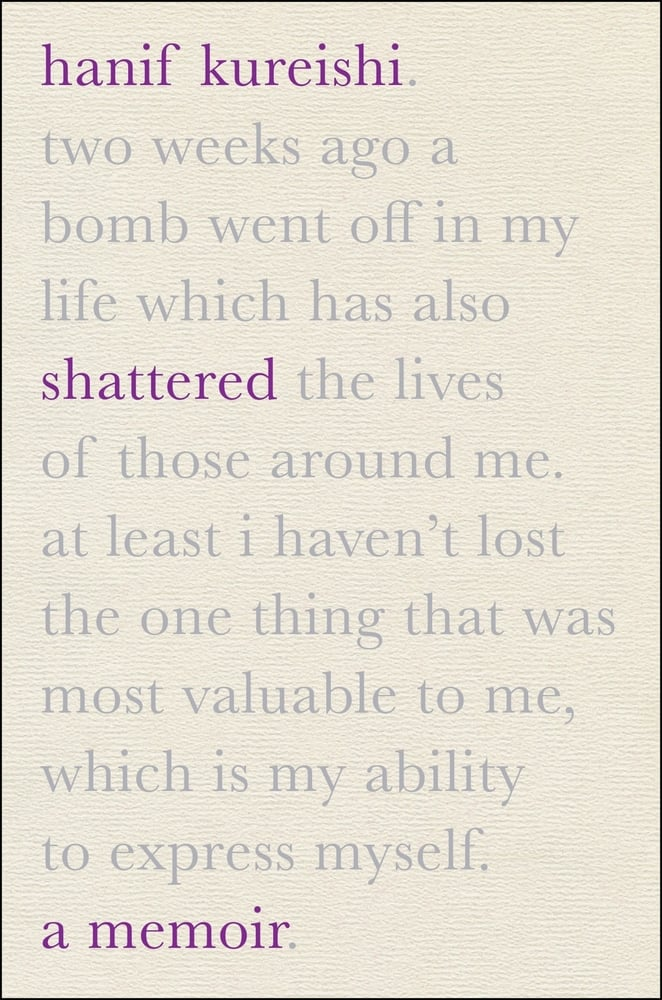Reviewed by Sara Pisak
 It’s honest to say that after a fall on Boxing Day whereas in Rome, Hanif Kureishi felt his life and the lives of these round him had been shattered. Each typographically and metaphorically, the quilt of his memoir tells the reader as a lot with “hanif kureishi. shattered. a memoir” highlighted in a discovered poetry of realization. Nevertheless, what can also be made clear, not solely by the memoir’s cowl, however by Kureishi’s enclosed “dispatches,” is that his self-expression via writing has not been shattered.
It’s honest to say that after a fall on Boxing Day whereas in Rome, Hanif Kureishi felt his life and the lives of these round him had been shattered. Each typographically and metaphorically, the quilt of his memoir tells the reader as a lot with “hanif kureishi. shattered. a memoir” highlighted in a discovered poetry of realization. Nevertheless, what can also be made clear, not solely by the memoir’s cowl, however by Kureishi’s enclosed “dispatches,” is that his self-expression via writing has not been shattered.
Shattered: A Memoir (Ecco; February 2025) begins with Kureishi recounting the accident that modified his life. Feeling in poor health whereas watching tv, Kureishi fell ahead and awoke in a pool of blood together with his neck twisted. In consequence, Kureishi misplaced using his legs and arms. The memoir, recounting each the occasion and his restoration that follows, is dictated to his companion, Isabella, and his three sons.
Throughout the first few pages of Shattered, writing and collaboration emerge as a haven of creativity for Kureishi and his household to course of his accident, heal emotional and bodily misery, and consider their altered futures. He writes, “This writing I’ve achieved in hospital, dictated to Carlo and my household, has sustained me. I need to maintain going (267).”
With writing as a continuing a part of his identification, particularly within the thick of trauma, Kureishi leans into his writerly identification. He muses:
I’m conscious of this in my very own life; as a youngster I used to be so traumatized by racism and the unpleasantness of faculty that I started to learn and write at a exceptional price. You may say that trauma saved me and made me right into a author. One thing comparable is occurring right here: I’m discovering a manner to deal with the shock of my latest accident by writing via dictation (68).
As Kureishi finds his different figuring out components altering akin to his swift reckoning together with his identification as able-bodied changing into disabled, writing is the one fixed and relationship that continues to be comparatively unchanged. Though now, he should dictate his work, Kureishi confronts trauma to retrieve the salvageable classes, feelings, tales, and relationships he can use to manage and gasoline his writing.
Writing, concepts, and the best way his thoughts works, are the colleges he can maintain onto. Kureishi stares immediately on the unpleasantness of trauma and dictates all of it as a method to manage. He doesn’t stray away from the helplessness and loneliness he feels, the loss of life of a fellow affected person he befriends, and the assorted medical procedures he undergoes. The fixed and helpful school of writing echoes all through Shattered.
Kureishi tells the reader, “I’d like so as to add that I actually get pleasure from writing these dispatches from my mattress. Not less than I haven’t misplaced the one factor that was essentially the most helpful to me, which is my capability to specific myself (37).”
Within the capability to specific himself, Kureishi finds the great thing about collaboration. Kureishi is pressured to confront the truth that he’s not as unbiased as he was up to now and should depend on others for on a regular basis duties. His life is now a collaboration and partnership greater than ever between his companion, his sons, his associates, his medical doctors, his nurses, and his fellow sufferers. With the concept of partnership in thoughts, he additionally challenges the concept of the lone author.
Whereas discussing The Beatles, he wonders if the general public would have ever heard of Lennon and McCarthy with out one another? He goes on to state,
That is each a miracle and a horrible dependency. In my expertise, all artists are collaborationists. If you’re not collaborating with a selected particular person, you’re collaborating with the historical past of the medium, and also you’re additionally collaborating with the time, politics and tradition inside which you exist. There are not any people (15-16).
It sparks his personal revelations about writing, revising, modifying, and increasing the dispatches together with his son, Carlo. Writing as a collaborative act turns into a kind of freedom for Kureishi. He collaborates with not solely his son however with style, type, subject material, and different cultural/political matters. Collaboration in writing opens the door for his acceptance of collaboration in different areas of his life, the place his accident has made collaboration a necessity.
In these modified and modified relationships, Kureishi’s relationship to writing as a craft, his unique identification as a author, his collaboration with different writers and the medium stays unchanged. Writing is a static and acquainted stronghold in his life, his longest collaboration, as a result of as Kureishi is aware of far too nicely, “Writers nurse the human soul via its troublesome journey on this unimaginable life (158).”
Meet the Contributor
 Sara Pisak earned an MA and MFA in nonfiction from Wilkes College. She is presently affiliate editor at The Disruptive Quarterly and a employees reviewer at Glass Poetry Press. Sara participates within the Poetry in Transit Program, and she or he has lately printed work in Door = Jar, Whale Highway Assessment, the Deaf Poets Society, 5:2:One Journal, Moonchild Journal, Sure Poetry, and Boston Accent.
Sara Pisak earned an MA and MFA in nonfiction from Wilkes College. She is presently affiliate editor at The Disruptive Quarterly and a employees reviewer at Glass Poetry Press. Sara participates within the Poetry in Transit Program, and she or he has lately printed work in Door = Jar, Whale Highway Assessment, the Deaf Poets Society, 5:2:One Journal, Moonchild Journal, Sure Poetry, and Boston Accent.



Leave a Reply